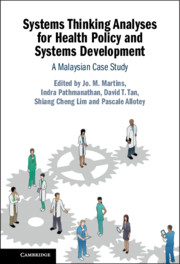Appendix III Supplementary Tables
| Causes | 1960, rank (%) | 1974, rank (%) | 1996, rank (%) | ||
|---|---|---|---|---|---|
| Admissions | Deaths | Admissions | Deaths | Deaths | |
| Accidents | 1 (10.14) | 7 (5.63) | 1 (13.48) | 3 (10.53) | 3 (9.44) |
| Skin diseases | 2 (4.11) | − | 6 (2.58) | − | − |
| Gastroenteritis/digestive system diseases | 3 (3.90) | 3 (8.93) | 3 (3.71) | 8 (2.87) | 7 (4.60) |
| Complications of pregnancy | 4 (3.72) | 10 (2.64) | 2 (4.97) | − | − |
| Tuberculosis | 5 (2.88) | 5 (7.36) | − | 7 (4.40) | − |
| Malaria | 6 (2.65) | − | − | − | − |
| Mental illness | 7 (2.42) | − | 4 (3.10) | − | − |
| Bronchitis | 8 (2.34) | − | 10 (1.95) | − | − |
| Pyrexia of unknown origin | 9 (2.21) | − | 8 (2.16) | − | − |
| Heart diseases | 10 (1.77) | 2 (9.94) | 5 (2.59) | 2 (15.02) | 1 (15.61) |
| Disease of early infancy | − | 1 (15.2) | 7 (2.29) | 1 (18.99) | 6 (7.82) |
| Cardiovascular/cerebrovascular diseases | − | 8 (3.17) | 9 (2.08) | 4 (7.32) | 4 (9.27) |
| Pneumonia | − | 4 (8.48) | − | 6 (6.50) | 8 (4.17) |
| Neoplasms | − | 6 (6.03) | − | 5 (6.71) | 5 (8.92) |
| Deficiency diseases | 9 (2.81) | − | − | 10 (1.43) | − |
| Liver diseases | − | − | − | 9 (2.32) | − |
| Septicaemia | − | − | − | − | 2 (10.12) |
| 1957 | 1970 | 1983 | 1990 | 2000 | 2010 | 2016/2017 | |
|---|---|---|---|---|---|---|---|
| Infant mortality rate (per 1,000 live births) | 68.9 | 39.4 | 20.2 | 13.1 | 6 | 6.7 | 7.3 |
| Neonatal mortality rate (per 1,000 live births) | 29.6 | 21.4 | 12.3 | 8.5 | 3.1 | 4.3 | 4.2 |
| Toddler mortality rate (per 1,000 population aged 1–4 years) | 8 | 4.2 | 1.7 | 0.9 | 0.5 | 0.4 | 0.4 |
| Under-5 mortality rate (per 1,000 live births) | 110.4 | 55.9 | 26.6 | 16.8 | 7.9 | 8.5 | 8.6 |
| Disease control programme | Key strategies | Supporting strategies | Outcomes | ||||
|---|---|---|---|---|---|---|---|
| Prevention | Screening/ detection | Treatment and management | Human resource and capacity building | Surveillance system | Community participation | ||
| Yaws Elimination Campaign, 1954 – with assistance from WHO and UNICEF (UN Children’s Fund) |
| Mass treatment using procaine penicillin for open cases, latent cases and contact. | Yaws elimination unit was set up. |
| |||
| Filariasis Control Programme, 1960 | Case detection: House and population censuses and nocturnal mass blood survey. Whenever a nocturnal survey was not feasible, the diethylcarbamazine (DEC) stimulation technique was used during follow-up of cases or in school surveys. | Mass treatment in the locality using DEC: Individual case follow-up was carried out after 3–5 months while the locality was resurveyed after about 2–3 years. |
|
| |||
|
| Case finding programme: Early case detection among symptomatic and high-risk groups (at least 66%) in the community using mass miniature radiography (MMR), X-ray, bacteriological and sputum examination and referred for appropriate treatment. |
|
| 1973: The TB registry was established. | Working with MAPTB to provide socio-economic aid and increase community participation to reduce defaulter rates for treatment. |
|
| Malaria Eradication Programme, 1967–82: Part of the Global Malaria Eradication Programme | Vector control: Residual insecticide spraying using DDT (started with DDT wettable powder and replaced by DDT emulsion)
Health education for the community. |
|
| Vertical organisational structure:
Specially trained personnel deployed to map and spray all houses and structures, perform census counts, perform mass blood surveys and general surveillance activities. |
|
| |
| National Leprosy Control Programme Peninsular Malaysia (1969), Sarawak (1974), Sabah (1985) | Early case finding by staff of the ‘skin clinics’. |
| A Central Registry of cases was established at the National Control Centre: it registered 50% or 8,710 estimated cases in 1969. | Worked with MaLRA to reduce stigma and facilitate social integration of patients. | 1994: achieved WHO elimination status of <1 per 10,000 population. | ||
|
|
|
| Development of a mapping system and improved monitoring system at district and local levels. |
| ||

